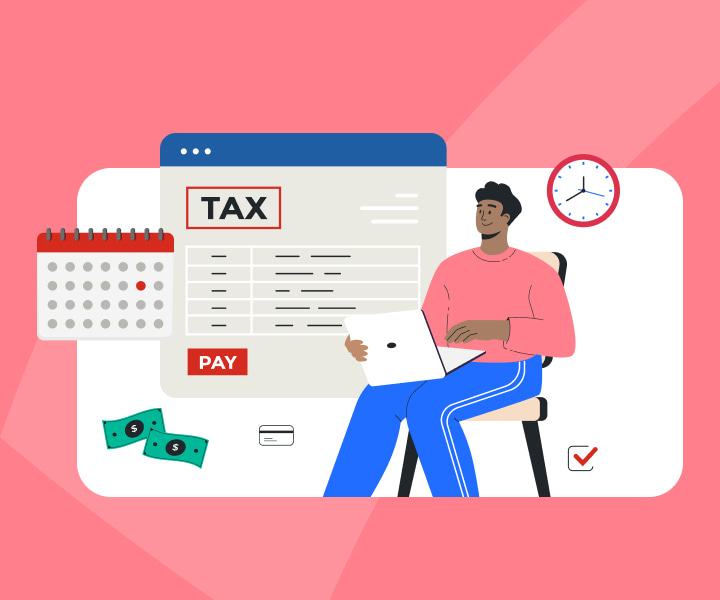Get all the expert help you need for only $20 when you’re 25 or younger with TurboTax
How to Calculate, Claim, and Maximize Your Tax Refund
TurboTax Canada
February 10, 2025 | 5 Min Read
Updated for tax year 2025

Have you ever unexpectedly found a (forgotten) $20 bill in your pocket? That’s the kind of happy surprise a tax refund can bring! But what, exactly, is a tax refund? And how do you know if you’re eligible for one?
Tax refunds might seem like a mystery, but they’re actually pretty straightforward. We’re here to break it down for you: We’ll guide you through the basics of understanding tax refunds, how to calculate them—and we’ll even share some savvy ways you can put your refund to good use!
Key Takeaways
- A tax refund is a return of any income tax overpayments you’ve made during the tax year.
- Your eligibility for a tax refund depends on factors like the amount of tax your employer has withheld and the deductions and refundable tax credits you can claim.
- Calculating your tax refund isn’t complex—it requires some basic math and an understanding of your income and deductions.
Where’s my tax refund? Understanding the refund process
Imagine you’re shopping online and you accidentally order two of the same item. You return the extra one, and the store refunds your money, right? That’s pretty much how a tax refund works: If you’ve paid more taxes than you should have, the Canada Revenue Agency (CRA) gives you back your money.
It’s like getting a surprise bonus, except it was your money to begin with. So, while it’s exciting to get a tax refund, remember, it’s not a windfall—it’s a return of money you’ve already paid.
So, you’re wondering if you’re entitled to a tax refund? Here’s the scoop: Several situations could put you in the tax refund zone, including:
- Overpayment through employer deductions. Picture your employer as an overprotective parent, taking a bit too much from your paycheque for taxes (so you won’t get hit with an unexpected tax bill come tax time). If this is the case, you could be in for a refund.
- Overpayment through installment payments. If you’re self-employed and have been too generous with your quarterly tax payments, you might have overpaid. It’s like you’ve been giving the CRA an extra slice of your income pie, and now they’re giving it back.
- Registered Retirement Savings Plan (RRSP) contributions. Have you been making contributions to your RRSP? RRSP contributions can reduce your taxable income, which might result in a tax refund. You’re not only saving for your future—you’re also reducing your current tax bill. Talk about a win-win!
- Deductions and credits claimed. Think of the deductions or certain credits you’re eligible for as secret power-ups in the game of taxes: When you claim them on your return, they can lower your tax bill and result in a refund!
The secret sauce: factors that determine how much you’ll get back
Right now, you’re probably thinking, “How much will I get back in taxes?” Luckily, the amount of your refund isn’t left to chance. Several factors influence how much tax you have to pay—and the size of your tax refund, if you’ve overpaid.
Here’s the lowdown:
- Your income. Your income is a major player in the tax refund game. The more you earn, the more tax you’re expected to pay. So if you’ve been paying taxes as if you’re at a higher income level than you actually are in, you could be looking at a significant refund.
- Tax withheld. Remember that “employer as an overprotective parent” scenario? Depending on the amount of tax your employer has held back, you could be in for a nice-size refund. It’s like your employer has been putting some of your money in a piggy bank, and now it’s time to break open the bank.
- Your eligible deductions. Remember how tax deductions are like video-game power-ups? The more deductions you can claim, the lower your taxable income—and if you’ve paid tax based on your income before taking these deductions into account, this could have an effect on the size of your refund.
- Refundable vs. non-refundable tax credits. Unlike tax deductions, not all tax credits affect the amount of your tax refund. Refundable tax credits can increase how much you get back (kind of like a coupon you can use even if your tax bill is zero), but non-refundable tax credits can only reduce any tax you owe to zero (so they’re great if you owe taxes, but they don’t do much if you don’t).
From zero to tax refund hero: how to calculate your tax refund
You don’t have to be a financial guru to calculate your tax refund. With a bit of organization and some basic math, you can figure out the amount pretty easily. Here’s your step-by-step guide:
- Gather your tax documents. Collect all the necessary paperwork, such as your T4s (for your employment income), T5s (if you have investment income), and any receipts for deductions. It’s like getting your dream team together before heading out to beat that final boss.
- Calculate your total income. Add up all your income from different sources (this is where you’ll need your T4s and any T5s). Your total income is your gross income, before any deductions.
Example: T4 income = $40,000
Total income = $40,000
(Note: This example focuses on your T4 income, as that’s the most common situation. But if you do have investment income, your total income would include the income on any T5s you’ve received as well.)
- Calculate your taxable income. Subtract any deductions (like RRSP contributions) from your total income. This is your base for your tax calculation.
Example: $40,000 (total income) – $5,000 (RRSP contributions) = $35,000 (taxable income)
- Calculate your total tax payable. Apply the appropriate federal and provincial tax rates to your taxable income, to determine your total tax payable.
Example (2025):
For a taxable income of $35,000:
Federal tax rate (2025): 14.5%
Ontario tax rate (2025): 5.05%
Federal tax: $35,000 × 14.5% = $5,075.00
Provincial tax: $35,000 × 5.05% = $1,767.50
Total tax payable: $5,075.00 + $1,767.50 = $6,842.50
5. Determine your refund (or balance owing). Compare your total tax payable with the amount withheld by your employer (or the amount you’ve paid in tax installments, if you’re self-employed). If you’ve overpaid, victory is yours—a refund awaits!
Example:
Tax withheld = $10,000
Refund = $10,000 – $7,017.50 = $2,982.50
- Review your calculations. Double-check your math and make sure everything adds up. It’s like checking that your game strategy lines up before you leap into action—you want to get all the details right.
And if you need a quick estimate of the refund you can expect, or any tax return estimates, try an income tax refund calculator—like the TurboTax calculator.

Scored a tax refund? Here’s how to make the most of it
You’ve done the math, and you’re getting a refund. Congrats! But before you start planning a shopping spree, consider these smart ways to put your refund to good use:
- Crush your debt. Got student loans or credit card debt? Your tax refund can help you take a bite out of it.
- Create a safety net. Life is full of surprises—and not all of them are fun. Setting aside some of your refund for emergencies can give you peace of mind.
- Jumpstart your RRSP. Seriously, your future self will thank you! Plus, contributing to an RRSP can reduce your taxable income for the next tax year.
- Invest in learning. Whether it’s a coding boot camp or a cooking class, investing in yourself is always a good idea.
- Save for a down payment. Dreaming of your own place? Your tax refund can help you reach your down-payment goals faster.
From understanding the basics to making the most of your refund, you’re now equipped with the knowledge to navigate tax season like a pro.
Related articles

© 1997-2024 Intuit, Inc. All rights reserved. Intuit, QuickBooks, QB, TurboTax, Profile, and Mint are registered trademarks of Intuit Inc. Terms and conditions, features, support, pricing, and service options subject to change without notice.
Copyright © Intuit Canada ULC, 2024. All rights reserved.
The views expressed on this site are intended to provide generalized financial information designed to educate a broad segment of the public; it does not give personalized tax, investment, legal, or other business and professional advice. Before taking any action, you should always seek the assistance of a professional who knows your particular situation for advice on taxes, your investments, the law, or any other business and professional matters that affect you and/or your business.









